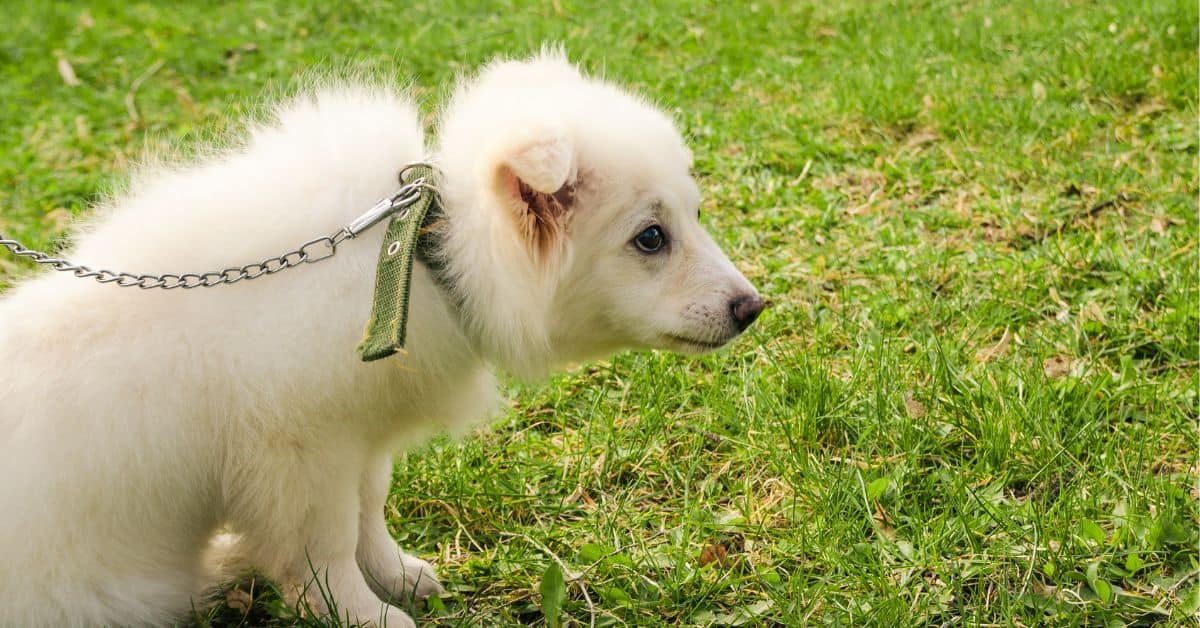Today, we’re diving into the signs your dog feels uncomfortable.
Understanding your dog’s non-verbal cues is crucial as it can help prevent stressful situations and even health issues.
By recognizing these signs early, you can create a safer and happier environment for your pet.
So, let’s uncover the subtle language of dogs that often goes unnoticed.
Sign #1: Avoiding Eye Contact
Dogs communicate volumes with their eyes.
In the canine world, eye contact can be interpreted in various ways, from showing affection to challenging another dog.
When your dog is avoiding eye contact, it often signals discomfort or submission.
This avoidance is their way of telling you they’re not a threat or they’re feeling uneasy.
If you notice your dog deliberately looking away, it might be time to assess the situation.
Give them space and avoid forcing interaction, as this can increase their stress.
Sign #2: Yawning And Licking Lips
Yawning and licking lips in dogs aren’t always a sign of sleepiness or hunger.
These behaviors can be a response to stress or nervousness.
A stress yawn looks different from a relaxed yawn—it’s often more prolonged and intense.
Similarly, when a dog frequently licks its lips, it’s a signal that they might be feeling anxious.
It’s vital to observe the context of these actions.
If there’s no obvious reason for your dog to yawn or lick their lips, they might be stressed.
In such cases, reassess their environment to identify potential stressors.
Sign #3: Tucked Tail
The tail of a dog is like a mood barometer.
A high, wagging tail usually signifies happiness, while a tail tucked between the legs indicates fear or anxiety.
This posture can tell us that a dog is not feeling secure.
If your dog’s tail is tucked, it’s essential to observe what might be causing this fear response.
Creating a calm environment and providing a safe space for your dog can help them feel more secure.
Always approach your pet with gentleness to avoid overwhelming them further.
Sign #4: Pacing And Inability To Settle
Pacing is a behavior that signifies restlessness or anxiety in dogs.
If your dog is walking back and forth repeatedly or cannot seem to find a comfortable spot to relax, it’s a clear sign they’re feeling uneasy.
This discomfort could be due to various factors, from environmental changes to internal distress.
To aid a dog in distress, establish a routine, provide a quiet resting place, and consider calming techniques such as soothing music or a comforting scent.
Sign #5: Whining Or Barking
Dogs communicate with us through their vocalizations, which include a range of sounds from whines to barks.
Whining or barking can be a sign of excitement, but it can also indicate stress or discomfort.
To differentiate between the two, pay attention to the pitch and frequency of the vocalization and look for other signs of stress.
If your dog’s vocalizing seems to stem from discomfort, it’s time to investigate the cause and address their needs.
Sign #6: Showing The Whites Of Their Eyes (Whale Eye)
The “whale eye” is when a dog shows the whites of their eyes, often seen when they turn their head away but keep their gaze fixed on something or someone.
This body language can signal anxiety or unease.
It’s crucial not to startle or corner a dog exhibiting “whale eye,” as they may feel trapped and react out of fear.
Instead, give them space and allow them to come to you when they feel ready, ensuring they always have an escape route in any situation.
Sign #7: Shedding And Drooling
Unexpectedly, stress can affect a dog’s physical state, leading to increased shedding or drooling.
While some breeds naturally shed or drool more than others, a noticeable increase in either can be a sign of anxiety.
When shedding becomes excessive or if your dog suddenly starts to drool without an apparent cause, it’s time to take note.
These signs can be a dog’s reaction to stress.
If you encounter such changes, consider potential stress triggers and consult with your vet to ensure there’s no underlying health issue.
Sign #8: Changes In Body Posture
A dog’s body language is a window into their emotional state.
A stiff, still posture can be a defense mechanism, indicating discomfort or fear, whereas a relaxed stance with a soft, wiggly body typically shows contentment and trust.
Defensive postures may include a lowered head, raised hackles, and a body that’s pulled tightly inward.
It’s imperative to create a stress-free environment that allows your dog to feel secure and loved, encouraging them to adopt more open and relaxed postures.
Understanding these signs of discomfort in your dog is an essential aspect of responsible pet ownership.
It enables you to address issues before they escalate and to provide a nurturing environment for your beloved companion.
Always approach your dog with empathy and patience, and remember that each pet may exhibit stress in different ways.
By being attentive and responsive to your dog’s needs, you can ensure a strong bond and a happy, healthy life together.
Remember, when in doubt, a consultation with a veterinarian or a professional dog behaviorist can provide tailored advice for your furry friend’s well-being.
Before You Go…
You now know the signs your dog feels uncomfortable.
If you want to learn more, read the following articles too!
Or watch this video:


